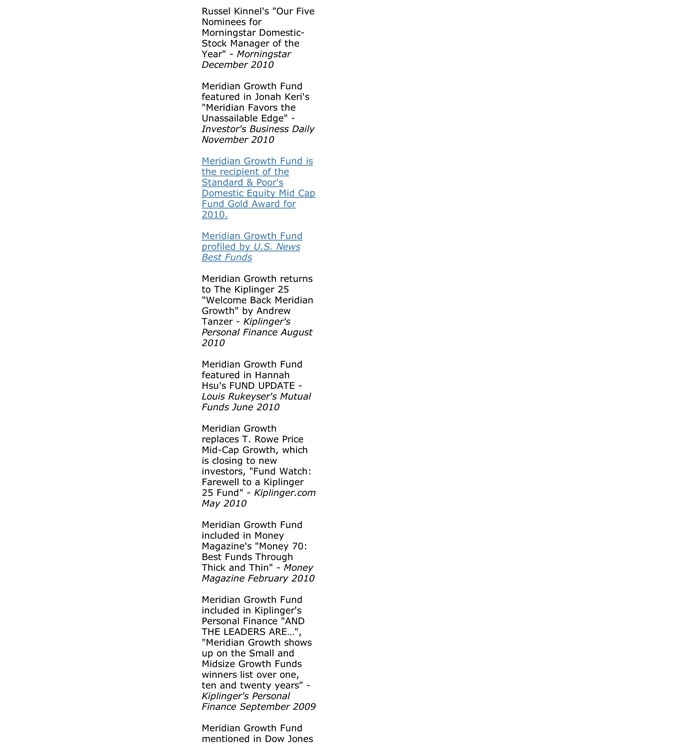How Good Are Morningstar’s Fund PicksKiplinger
Post on: 15 Июль, 2015 No Comment

Over the long haul, Morningstar’s gold-rated funds have topped their indexes. Below are descriptions of three of the firm’s less-well-known selections.
About two-thirds of actively managed funds fail to beat their benchmarks. That’s one of the strongest arguments for investing in index funds, which merely seek to match their bogeys. However, I think it is possible to identify funds that will top the market averages, and a good place to start is with Morningstar’s top-rated funds.
See Also: The Five Best Stock Funds to Own Now
The numbers show that the analysts are equal to the task. Over the past 10 years through May 30, Morningstar’s gold-rated diversified U.S. stock funds (previously called analyst picks) on average returned 8.1% annualized, an average of 0.3 percentage point per year ahead of Standard & Poor’s 500-stock index. Over the same stretch, gold-rated diversified developed-market foreign stock funds returned 9.1% annualized, on average, topping the MSCI EAFE index by 2.0 percentage points per year. And Morningstar’s gold-rated intermediate-term bond funds returned an annualized 5.6%, on average, beating the Barclay’s Aggregate U.S. Bond index by 0.6 percentage point per year.
A few caveats. The margins for U.S. stock funds and bond funds aren’t overwhelming. The Morningstar returns for the past three and five years are roughly as strong, relative to the indexes, for gold-rated foreign stock and intermediate-term bond funds. But the average Morningstar pick among U.S. stock funds trailed the S&P 500 over the past three and five years. Russ Kinnel, Morningstar’s director of fund research, says that actively managed funds, which typically hold some cash, have had trouble keeping up over the past five years because of the stock market’s meteoric and nearly non-stop ascent.
Nor are Morningstar’s returns adjusted for risk—something Kinnel says he would like to compute in the future. The Hulbert Financial Digest. which tracks the returns of investment newsletters, shows that Morningstar’s picks have delivered market-beating risk-adjusted returns, although Hulbert tracks a somewhat different universe. Since Hulbert began monitoring the Morningstar Fund Investor newsletter on June 30, 2005, through May 30, the newsletter’s three model portfolios (consisting mostly of gold-rated funds but including some other actively managed funds and even a few index funds) returned, on average, 7.1% annualized, 0.7 percentage point per year less than the S&P 500. But the Morningstar portfolios currently hold 34% in bond funds, as well as a big chunk in conservative stock funds. Bottom line: The Morningstar portfolios exhibited about one-third less volatility than the S&P index. The portfolios’ biggest 12-month loss was 29.4%, compared with a loss of 43.3% for the S&P 500.
How does Morningstar pick standout funds? Good returns are important, of course, particularly risk-adjusted returns. But Morningstar also favors funds with low expense ratios, that are run by managers who invest a healthy chunk of their own money in their funds and that come from firms with a sound corporate culture. Morningstar research has shown that all of these factors are good predictors of future success.
Most Morningstar fund picks won’t surprise any Kiplinger readers—or, for that matter, readers of my column. So I asked Kinnel for a short list of slightly lesser-known gold-rated funds. Descriptions of his picks are below.

The managers of Dodge & Cox Income (DODIX ) apply the same kind of careful company research to investing in bonds that they do at their firm’s better-known stock funds. Most of the fund is invested in investment-grade corporate bonds and government-backed mortgage securities. So it’s no surprise that the average credit quality of Income’s holdings is relatively high, at single A. But the fund is moderately susceptible to rising interest rates (bond prices and rates generally move in opposite directions). If rates were to rise one percentage point, the fund’s price would fall about 4.5%. Expenses are 0.43%. Over the past five years through July 18, the fund returned an annualized 6.4%, compared with 4.8% annualized for Barclay’s U.S. Aggregate Bond index (all fund returns are through July 18).
LKCM Equity (LKEQX ). based in Fort Worth, has been putting up solid returns since 1995. Lead manager Luther King has been using much the same methods to pick stocks since 1979. But today he has three co-managers and a large analyst team. He and his colleagues focus on large companies, looking for those that have strong cash flow and high returns on equity (a measure of profitability) and that sell at bargain prices. Over the past 10 years, LKCM gained an annualized 9.0%, an average of 0.8 percentage-point per year better than the S&P. Expenses are 0.80% annually.
Primecap Odyssey Stock (POSKX ) is the tamest of the three funds run by Primecap Management under the Los Angeles firm’s own name. The fund is a near-clone of the storied Vanguard Primecap (VPMCX ), which has produced solid returns since its 1984 launch but is closed to new investors. Like the other Primecap funds, Odyssey Stock has more than half of its assets in two sectors: technology and health care. But, unlike its friskier siblings, this fund has almost all of its assets in large, well-established companies. Expenses are 0.63% annually. Returns often diverge sharply from the S&P 500, depending upon the direction of the health and tech sectors. From Odyssey Stock’s inception in late 2004, the fund returned an annualized 9.8%—an average of 1.7 percentage points per year more than the S&P.
Steve Goldberg is an investment adviser in the Washington, D.C. area.














